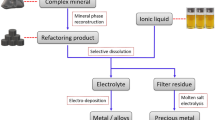This article demonstrates that the yields of gold, silver, and copper increase when sulfide gold-bearing ore is exposed to nanosecond electromagnetic pulses (NEMP) in an aqueous medium. The pulse generator was operated under a duration of 1 ns, pulse rise front of 0.1 ns, amplitude of 15 kV, repetition rate of 1 kHz, and pulse power of 4.5 MW to study the impact of NEMP on ore extraction. The research objects were sulfide ores obtained from the open pit of Bashkir Gold Mining Company. Results revealed the possibility of using the proposed method to prepare gold-bearing ores for cyanidation to increase their output of precious and non-ferrous metals.

Similar content being viewed by others
References
G. A. Mesyats, Pulse Power Engineering and Electronics [in Russian], Nauka, Moscow (2004).
M. T. Pichugina, Powerful Impulse Technology [in Russian], Izdatelstvo TPU, Tomsk (2005).
G. Lin, S. Lu, and J. Liu, “Transmitting boundary for transient analysis of wave propagation in layered media formulated based on acceleration unit-impulse response,” Soil Dyn. Earthq. Eng., 90, 494–509 (2016).
A. P. Lysenko, A. Yu. Nalivaiko, D. S. Kondratyeva, and S. V. Kondratyev, “Electrochemical method for producing ferrotitanium,” Tsvetn. Metall., No. 6, 34–38 (2019).
A. E. Pelevin, N. A. Sytykh, “The use of separators with increased magnetic field induction in the beneficiation of titanomagnetite ore,” Obogashchen. Rud, No. 2, 15–20 (2020).
N. B. Shakhova, T. A. Yurmazova, H. T. Tuan, and A. N. Tuan, “Pulsed electric discharge in active metallic grains for water purification processes,” Procedia Chem., 15, 292–300 (2015).
H. N. Rajha, A.-M. Abi-Khattar, S. E. Kantar, N. Boussetta, N. Lebovka, R. G. Maroun, N. Louka, and E. Vorobiev, “Comparison of aqueous extraction efficiency and biological activities of polyphenols from pomegranate peels assisted by infrared, ultrasound, pulsed electric fields and high-voltage electrical discharges,” Innov. Food Sci. Emerg. Technol., 58, 102212 (2019).
M. Chadni, N. Grimi, I. Ziegler-Devin, N. Brosse, and O. Bals, “High voltage electric discharges treatment for high molecular weight hemicelluloses extraction from spruce,” Carbohydr. Polym., 222, 115019 (2019).
S. V. Kotunov, V. O. Krasnogorov, D. Yu. Tupikov, and P. E. Ivanov, “Results of testing a new roller-type magnetic separator on manganese ores of the Selezenskoye deposit,” Obogashchen. Rud, No. 5, 37–41 (2017).
B. Sun, Y. Xin, X. Zhu, Z. Gao, Z. Yan, and T. Ohshima, “Effects of shock waves, ultraviolet light, and electric fields from pulsed discharges in water on inactivation of Escherichia coli,” BBA–Biomembranes, 1859, 2040–2050 (2017).
R. C. Burke, S. M. Bardet, L. Carr, S. Romanenko, D. Arnaud-Cormos, Ph. Leveque, and R. P. O’Connor, “Nanosecond pulsed electric fields depolarize transmembrane potential via voltagegated K+, Ca2+ and TRPM8 channels in U87 glioblastoma cells,” Bioelectrochemistry, 120, 112–119 (2018).
F. Yang and Y. Lu, “Emission enhancement of femtosecond laser-induced breakdown spectroscopy by combining nanoparticle and dual-pulse on crystal SiO2,” Opt. Laser Technol., 93, 194–200 (2017).
V. F. Balakirev, V. V. Crymsky, V. A. Baturin, and A. P. Greshnyakov, “Electropulse processing of aqueous solutions,” Proceedings of international conference VI Radiation-Thermal Effects and Processes in Inorganic Materials, Izdatelstvo TPU, Tomsk, 419–423 (2008).
V. A. Chanturia, E. L. Chanturia, I. Zh. Bunin, M. V. Ryazantseva, E. V. Koporulina, A. L. Samusev, and N. E. Anashkina, “Influence of acid and electrochemical processing of mineral suspensions on the physicochemical and electrical properties of tantalite, columbite, zircon, and feldspar,” Fiziko-tekhnichesk. Problem. Razrabot. Polezn. Isk., No. 4, 142–157 (2016).
A. F. Usov, V. A. Tsukerman, and V. I. Kurets, “Experience in the development of tools for electro-impulse disintegration of materials,” Gornyy Informatsionno-analitichesk. Byulleten (scientific and technical journal), 310–318 (2011).
I. Zh. Bunin, N. S. Bunina, V. A. Vdovin et al., “Experimental study of the non-thermal effect of powerful electromagnetic pulses on refractory gold-bearing raw materials,” Izv. An. Ser. Fizicheskaya, 65, No. 12, 1788–1792 (2001).
V. A. Chanturia, I. Zh. Bunin, and A. T. Kovalev, “The role of gas outflow from nanosecond breakdown channels in the process of electric pulse disintegration of sulfide minerals,” Izv. RAN. Ser. Fizicheskaya, 74, No. 5, 714–717 (2010).
V. A. Chanturia, I. Zh. Bunin, A. T. Kovalev, and E. V. Koporulina, “The processes of formation of micro- and nanophases on the surface of sulfide minerals under the action of nanosecond electromagnetic pulses,” Izv. RAN. Ser. Fizicheskaya, 76, No. 7, 846–850 (2012).
Reinhard Müller-Siebert and Joel Colli, Pat. 2670126 RF. IPC B02C 19/18RU2670126 C1, Method (Options) and Devices for Crushing into Blocks and/or Weakening of Bulk Material Using High-Voltage Discharges (Invention); submitter 02/27/2015; published08/18/2018, Bul. No. 29.
Selfrag, High Voltage Pulse Power Fragmentation; URL: http://www.selective-fragmentation.com (date of reference 07/13/2020).
A. F. Usov, A. S. Potokin, “Pulse transformation of voltage and energy for electro-pulse destruction of materials,” Proceedings of Kola Science Center RAS, No. 7 (26) (2014); URL: https://cyberleninka.ru/article/n/impulsnoe-transformirovanie-napryazheniya-ienergii-dlya-elektroimpulsnogo-razrusheniya-materialov (date of reference: 07/16/2020).
A. F. Usov, A. S. Potokin, and D. V. Ilyin, “Investigation of methods of energy optimization of technological use of discharge-pulse low-temperature plasma in condensed media,” Proceedings of Kola Science Center RAS, No. 5-13 (39) (2016); URL: https://cyberleninka.ru/article/n/issledovanie-metodov-energeticheskoy-optimizatsii-tehnologicheskogo-ispolzovaniya-razryadnoimpulsnoy- nizkotemperaturnoy-plazmy-v (date of reference: 07/16/2020).
D. G. Grishin, V. V. Krymsky, “Electric pulse activation of water,” Collection Engineering, Innovation, Investment, Issue 7, ed. V. V. Erofeev, Chelyabinsk, Izd. ChNC RAEN, ChelCNTI, 106–109 (2005).
Author information
Authors and Affiliations
Corresponding author
Additional information
Translated from Metallurg, Vol. 64, No. 12, pp. 51–55, December, 2020.
Rights and permissions
About this article
Cite this article
Krymsky, V.V., Mingazheva, Y.G. & Sultanov, Z.Y. Opening of Sulfide Gold-Bearing Ores using Nanosecond Electromagnetic Pulses in Aqueous Medium. Metallurgist 64, 1288–1294 (2021). https://doi.org/10.1007/s11015-021-01117-w
Received:
Published:
Issue Date:
DOI: https://doi.org/10.1007/s11015-021-01117-w




